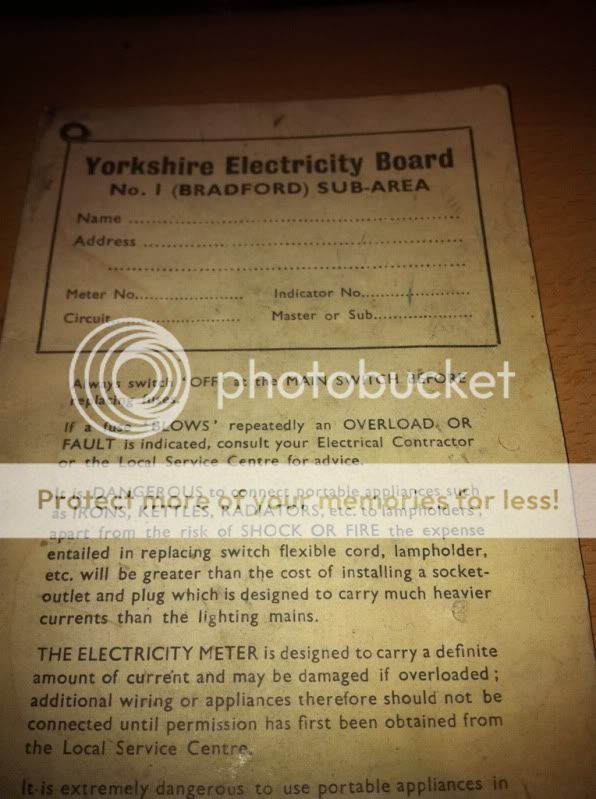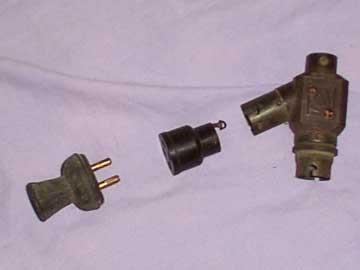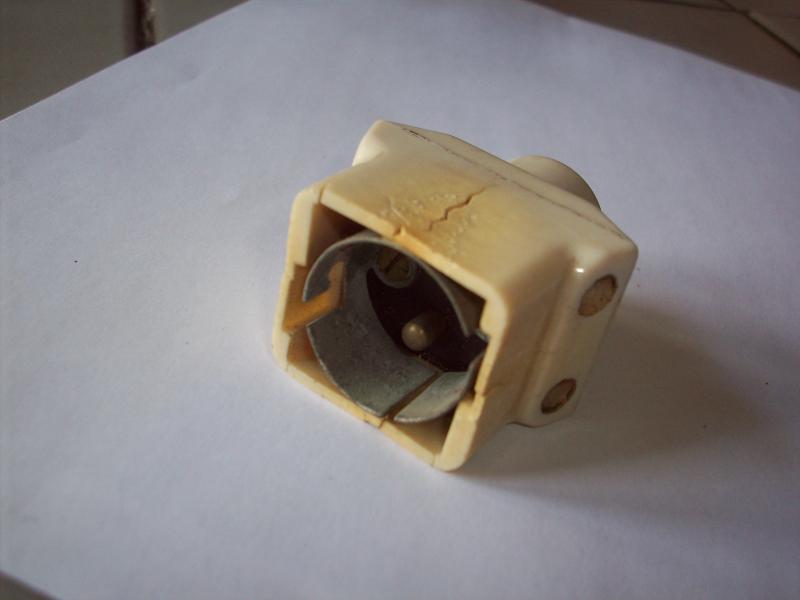I was telling my mum that I had arranged to have the electrics tested. This led to her telling me it was common to only have one light and one socket per room in her day. She then said it was normal to remove the bulb and connect other appliances through the light fitting. Is this true or is she once again winding me up? 
You are using an out of date browser. It may not display this or other websites correctly.
You should upgrade or use an alternative browser.
You should upgrade or use an alternative browser.
Is this true?
- Thread starter Robgers
- Start date
Sponsored Links
- Joined
- 27 Jan 2008
- Messages
- 23,661
- Reaction score
- 2,666
- Location
- Llanfair Caereinion, Nr Welshpool
- Country

True
The original supplies had two meters one for lights and one for power and electric for power cost more. So although at the time illegal people would power items from the lights.
As time went on this duel supply stopped but power was often only taken to the hallway and landing common for a pre-war house to just have 2 x 16A sockets. So it was far easier to use an adaptor and plug the smoothing iron into the light socket. I still have an old adaptor use now for testing.
By 1954 when my parents house was built the 13A socket and ring main had come in so using one fuse they were able to have 5 sockets in their house when built.
At this point lights had no earth connection and it was 1966 before earths were required to lights. This lack of earth connection also led to not using light fittings to power items.
As we have moved to more and more electric items so the interaction between them and the chances of faults have increased. This has resulted in more and more rules to control how we use electric in the home.
Today buried cables are either made of a special material so drilling through it will always open the protective device or protected by a RCD. Also all bathroom items except for shaver outlet are protected by a RCD. Sockets under 20A are protected by a RCD. All sockets must have an earth and be non reversible. All this did not exist in 1954. And before the war no one had shuttered sockets. The 13A socket was designed during the war ready for the re-build after the war. And was designed to be able to use the ring main so using less copper which was in short supply after the war.
The original supplies had two meters one for lights and one for power and electric for power cost more. So although at the time illegal people would power items from the lights.
As time went on this duel supply stopped but power was often only taken to the hallway and landing common for a pre-war house to just have 2 x 16A sockets. So it was far easier to use an adaptor and plug the smoothing iron into the light socket. I still have an old adaptor use now for testing.
By 1954 when my parents house was built the 13A socket and ring main had come in so using one fuse they were able to have 5 sockets in their house when built.
At this point lights had no earth connection and it was 1966 before earths were required to lights. This lack of earth connection also led to not using light fittings to power items.
As we have moved to more and more electric items so the interaction between them and the chances of faults have increased. This has resulted in more and more rules to control how we use electric in the home.
Today buried cables are either made of a special material so drilling through it will always open the protective device or protected by a RCD. Also all bathroom items except for shaver outlet are protected by a RCD. Sockets under 20A are protected by a RCD. All sockets must have an earth and be non reversible. All this did not exist in 1954. And before the war no one had shuttered sockets. The 13A socket was designed during the war ready for the re-build after the war. And was designed to be able to use the ring main so using less copper which was in short supply after the war.
Ericmark, thank you for that explanation. Was the adaptor fitted to the appliances readily available for other purposes or did it appear as a way for people to get cheaper electricity?
- Joined
- 27 Jan 2008
- Messages
- 23,661
- Reaction score
- 2,666
- Location
- Llanfair Caereinion, Nr Welshpool
- Country

A little before my time. I read about it on IET web site some years ago. The adaptors when I was a boy were sold in Woolworths and many other places.
Today we never see them. Good job too.
There are some dangerous adaptors still around. I bought a radio and to comply with the law they have to be supplied with British plug and this was done by providing an adaptor. However the adaptor had no fuse. Also you can buy white plastic blanks to stick in sockets which because they are not electrical have no British standard and in fact disable the existing safety mechanism. In time I expect they will be banned. But because Europe does not use our system they do have a use in rest of Europe and free trade agreement makes it hard to stop the likes of Ikea from importing them and selling them in UK.
Today we never see them. Good job too.
There are some dangerous adaptors still around. I bought a radio and to comply with the law they have to be supplied with British plug and this was done by providing an adaptor. However the adaptor had no fuse. Also you can buy white plastic blanks to stick in sockets which because they are not electrical have no British standard and in fact disable the existing safety mechanism. In time I expect they will be banned. But because Europe does not use our system they do have a use in rest of Europe and free trade agreement makes it hard to stop the likes of Ikea from importing them and selling them in UK.
Sponsored Links
I must be even older than Eric, since I remember well the bayonet adapters. I don't remember having two meters and different pricing for lighting and power, but in many parts of the country houses could be supplied at two different voltages, and even with both AC and DC supplies, so it is quite likely that DC was cheaper than AC or vice versa. The supply in Cardiff was standardised at 240 V AC in the mid-fifties, but some more rural areas had multiple voltages until the sixties.
As far as I can remember we didn't have a socket-outlet in the main room of the house, so the light fitting had a two-way bayonet adaptor permanently fitted, a bulb in one of the outlets and the other used for the iron or the vacuum cleaner, as needed. There was of course no earth connection.
It was quite normal for appliances such as irons to be fitted with a bayonet plug by the shop or by the customer, and both the plugs and the adaptors (sometimes with one outlet switched) were widely available, including from Woolworths.
What a miracle so many of us survived!
As far as I can remember we didn't have a socket-outlet in the main room of the house, so the light fitting had a two-way bayonet adaptor permanently fitted, a bulb in one of the outlets and the other used for the iron or the vacuum cleaner, as needed. There was of course no earth connection.
It was quite normal for appliances such as irons to be fitted with a bayonet plug by the shop or by the customer, and both the plugs and the adaptors (sometimes with one outlet switched) were widely available, including from Woolworths.
What a miracle so many of us survived!
P
Paul_C
Here's one of the Bayonet Cap adapters in question, seen here tethered to a normal 2-pin 5A plug so that it wouldn't get lost when unplugged to use the appliance in a "normal" socket:

There were also BC plugs which could be fitted directly to the appliance cord, to avoid the need for an adapter. These were still available until quite recently.
And then because of some items being fitted with such BC plugs, there were adapters for the reverse conversion, allowing a BC plug (or a lamp, of course) to be connected to a regular 2-pin 5A socket, like this:

The adapter pictured above has swiveling pins, allowing it to fit either a 2-pin 5A socket or a 3-pin 5A type, in which the spacing is slightly different.
A multitude of other adapter combinations existed. You could get a double BC adapter, typically with a one BC outlet straight into which the lamp was fitted and another angled to the side into which the iron or other appliance could be connected when required. Sometimes they were both angled outward at about 45 degrees.
Some types had an integral push switch or pull cord to allow one of the outlets to be turned off individually. Some provided the straight through BC outlet for a lamp, but had a 2-pin 5A socket on the side. And so on.

There were also BC plugs which could be fitted directly to the appliance cord, to avoid the need for an adapter. These were still available until quite recently.
And then because of some items being fitted with such BC plugs, there were adapters for the reverse conversion, allowing a BC plug (or a lamp, of course) to be connected to a regular 2-pin 5A socket, like this:

The adapter pictured above has swiveling pins, allowing it to fit either a 2-pin 5A socket or a 3-pin 5A type, in which the spacing is slightly different.
A multitude of other adapter combinations existed. You could get a double BC adapter, typically with a one BC outlet straight into which the lamp was fitted and another angled to the side into which the iron or other appliance could be connected when required. Sometimes they were both angled outward at about 45 degrees.
Some types had an integral push switch or pull cord to allow one of the outlets to be turned off individually. Some provided the straight through BC outlet for a lamp, but had a 2-pin 5A socket on the side. And so on.
You could buy all sorts of stuff, often plugged into the bathroom light.
Lord knows how people did not kill themselves
Lord knows how people did not kill themselves
- Joined
- 27 Jan 2008
- Messages
- 23,661
- Reaction score
- 2,666
- Location
- Llanfair Caereinion, Nr Welshpool
- Country

I had forgotten about the double adaptors. Yes had them as well. I can remember on holiday in mid Wales the 110vdc supply and the pulsating bulbs in the farm house with regular power cuts all from local village generator.
J
joinerjohn
I too have early memories of these adaptors. I can remember my grandmother doing the ironing in the front room with one of these plugged into the light socket. My grandad had to use a set of stepladders to reach the socket. 

I was brought up with lots of these:
(in case it's not clear, there is a bayonet plug on the opposite side from the bayonet socket, and one 2-pin outlet on each side). As you can see, this one has been overheated to the point of developing multiple cracks.
It was a particularly 'cunning' design, since if you plugged things into one or both of the two pin sockets, and also plugged in a bulb, it was guaranteed that the flex(es) would lie against the hot bulb!
Kind Regards, John.
(in case it's not clear, there is a bayonet plug on the opposite side from the bayonet socket, and one 2-pin outlet on each side). As you can see, this one has been overheated to the point of developing multiple cracks.
It was a particularly 'cunning' design, since if you plugged things into one or both of the two pin sockets, and also plugged in a bulb, it was guaranteed that the flex(es) would lie against the hot bulb!
Kind Regards, John.
C
cumbriahandyman
I can remember when appliances came with the light plug fitted.


Well, depending on what it was plugged into, and if the cables could stand the current, I guess that may have been marginally safer than the adaptors!I can remember when appliances came with the light plug fitted.
I can actually remember (what I would now regard as) absolutely frightening 'christmas tress' of several adaptors 'in series' dangling from a single bayonet socket in my grandparents' house.
Mind you, these horrors don't only exist in ancient history. Somewhere (if I can find it I'll post a photo) I have a quite modern 'travel adaptor' whose repertoire of configurations includes ones which provide a '13A socket' fed from a BC or ES lamp socket. I must try to find it, because I'm intrigued to discover whether the socket has BS1363 written on it
Kind Regards, John
YEB don't recommend the practice though



DIYnot Local
Staff member
If you need to find a tradesperson to get your job done, please try our local search below, or if you are doing it yourself you can find suppliers local to you.
Select the supplier or trade you require, enter your location to begin your search.
Please select a service and enter a location to continue...
Are you a trade or supplier? You can create your listing free at DIYnot Local
Sponsored Links
Similar threads
- Replies
- 12
- Views
- 1K
- Replies
- 3
- Views
- 1K
- Replies
- 1
- Views
- 291
B


